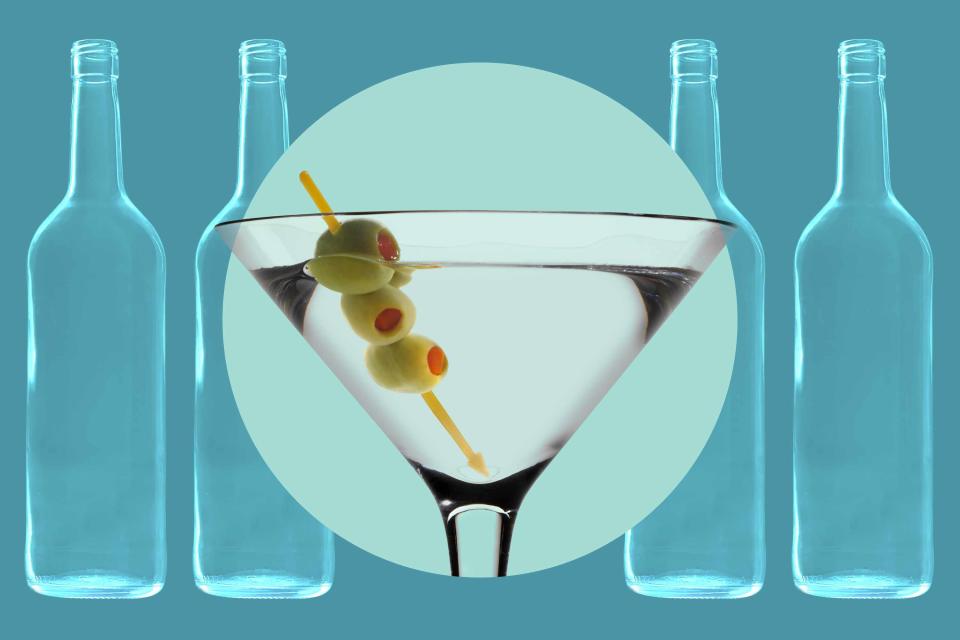Aquavit Can Upgrade Your Martini, Bloody Mary, and Many Other Classic Cocktails
What cocktail can't be improved with a flavorful punch of mint, dill, and anise?

Getty
As consumers continue seeking out boldly flavored spirits with rich cultural heritages, like mezcal, amaro, and soju, and bartenders search for new flavors to highlight, a spirit that’s centuries old in Scandinavia has been making an exciting entrance on American menus. Aquavit bears enough similarities to gin that it can be an easy next step for those who prefer the spirit, but it boasts its own intriguing flavor profile worth discovering.
What is aquavit?
Aquavit is a neutral grain- or potato-based spirit redistilled with herbs and botanicals, always including caraway and/or dill, and clocking in at 37.5% ABV or higher. The first recording of it being made dates back to Norway during the 16th century. Today, Norwegian producers make aquavit with a neutral potato-based spirit that must be aged for a year or more in oak. In Denmark and Sweden, aquavit is grain-based, and Danish aquavit leans more heavily on dill. American aquavit has fewer restrictions, and is really only required to have that caraway or dill.
To make aquavit, distillers macerate their herbs and botanicals in a neutral grain spirit for anywhere from 24 hours to five days. They remove the botanicals and take that liquid to distill, and the vapor passes through more botanicals on its way to turning back into liquid. Traditional aquavit, except for that in Norway, does not have to be aged and often isn’t; instead, it settles for a few weeks, during which distillers add water to bring down the proof.
Related: Our Best Martini Recipes
What does aquavit taste like?
Because aquavit almost always has caraway, you can always expect the seed’s flavors and aromas to play a significant-to-starring role. Think anise or licorice, rye-like spiciness, citrus, pepper, pine, and mint. From there, the flavor-and-aroma bouquet is in the hands of the distiller. The presence of dill can bring in a fresh, earthy, grassy character, with some more citrus.
At Halftone Spirits in Brooklyn, cofounder and head distiller Andrew Said Thomas also calls on fennel, juniper, bitter orange peel, licorice root, coriander, long pepper, lemon peel, angelica root, and Horace root for their aquavit. Distillers can also create different varietals. At Norden Aquavit in Chelsea, Michigan, cofounders Summer Ransom-Cleveland and Robyn Cleveland balance European tradition with creativity and organic, locally sourced ingredients. In addition to a traditional “Taffel,” or “Table” style, they offer an iteration aged for at least 12 months in American oak rye whiskey casks; a “pink aquavit” with strawberry, rhubarb, hibiscus, and Damask rose; and Heirloom Garden Dill, featuring dill seeds originally sourced from Denmark and then grown on-site at Norden.
How to drink aquavit
The best way to get to know aquavit is to sip a small, chilled shot straight. According to master distiller at Järvsö, Sweden’s Tevsjö Mill & Distillery Jonas Larsson, aquavit is enjoyed with celebratory feasts in Sweden. In Denmark, it’s a bit more of an everyday drink, and it’s not uncommon for people to have a small pour with smørrebrød for lunch.
American bartenders are incorporating aquavit’s unique flavors into cocktails. Its slightly savory profile makes it a natural fit for a Bloody Mary, but also makes for an intriguing counterpart to sweeter ingredients. “It works incredibly well with coconut and it works with rum,” Thomas says. “So, it’s great in tiki drinks.” Case in point: Linie Aquavit held a “World’s Best Aquavit Cocktail” competition, and bartenders from all over the globe participated. 2018’s winning cocktail, from Berlin-based Peggy Knuth, consisted of aquavit with lemon cordial and pandan extract.
Because aquavit itself tends to be so complex, it’s best to keep cocktails simple. At New York City’s renowned Nordic restaurant Aquavit, the Äppelkatten features aquavit with apple and heather oleo, while the Scandi Side teams it with cucumber, dill, and genepy. In Brooklyn, Ra Ra Rhino makes a case for upgrading your Martini with aquavit.
Related: Norwegian Vodka and Aquavit Are Now Protected Under E.U. Law
How to pair aquavit with food
Naturally, aquavit sings alongside Scandinavian fare. Larsson endorses enjoying it with traditional Swedish foods like pickled herring, as well as with cold cuts of meat and sausages. Still, Cleveland notes that aquavit-plus-herring might not be the most approachable introduction for American imbibers.
“I love to pair our dill aquavit with smoked salmon on a rye crisp with lemon aioli and capers or chives on top,” He says. “Or, for the party people, a little bump of caviar with a frozen dill aquavit chaser.”
Aquavit’s array of herbs and subtle spices does wonders with grilled meat. “An oak-aged aquavit with brisket or short ribs is amazing,” Larsson says. “Or, why not a smash burger?” Cleveland agrees and adds aged cheeses to the list. He also vouches for the dessert part of the menu. Similar to how aquavit’s savory-leaning profile tempers sweet cocktail ingredients, it balances after-dinner dishes and brings out new flavors. “With our more caraway-flavored aquavits, one of my absolute favorite ‘sleeper’ pairings is with chocolate and/or coffee,” Cleveland says. “Our Taffel Style is fantastic with more tropical/fruit flavors; think pineapple, mango, coconut, peach, and passion fruit. This is particularly true when paired with umami-rich, flavors.” Skål!
For more Food & Wine news, make sure to sign up for our newsletter!
Read the original article on Food & Wine.


